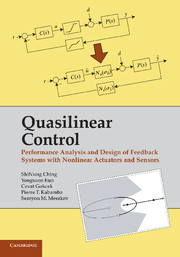 Quasilinear Control
Quasilinear Control Book contents
- Frontmatter
- Contents
- Preface
- 1 Introduction
- 2 Stochastic Linearization of LPNI Systems
- 3 Analysis of Reference Tracking in LPNI Systems
- 4 Analysis of Disturbance Rejection in LPNI Systems
- 5 Design of Reference Tracking Controllers for LPNI Systems
- 6 Design of Disturbance Rejection Controllers for LPNI Systems
- 7 Performance Recovery in LPNI Systems
- 8 Proofs
- Epilogue
- Abbreviations and Notations
- Index
- References
4 - Analysis of Disturbance Rejection in LPNI Systems
Published online by Cambridge University Press: 01 June 2011
- Frontmatter
- Contents
- Preface
- 1 Introduction
- 2 Stochastic Linearization of LPNI Systems
- 3 Analysis of Reference Tracking in LPNI Systems
- 4 Analysis of Disturbance Rejection in LPNI Systems
- 5 Design of Reference Tracking Controllers for LPNI Systems
- 6 Design of Disturbance Rejection Controllers for LPNI Systems
- 7 Performance Recovery in LPNI Systems
- 8 Proofs
- Epilogue
- Abbreviations and Notations
- Index
- References
Summary
Motivation: Analysis of disturbance rejection is intended to quantify the standard deviation of the output in closed loop LPNI systems. Unlike the linear case, the usual Lyapunov equation approach cannot be used for this purpose. Therefore, the first goal of this chapter is to provide a quasilinear method applicable to systems with nonlinear instrumentation. While some results in this direction for SISO systems have been described in Chapter 2, we treat here the MIMO case.
Also, we address the problem of fundamental limitations on achievable disturbance rejection in system with saturating actuators. As it is well known, in linear systems with minimum-phase plants, disturbances can be attenuated to any desired level. Clearly, this can not be the case in systems with saturating actuators. Therefore, the second goal of this chapter is to quantify fundamental limitations on disturbance rejection in closed loop LPNI systems and characterize tradeoffs between the authority of the actuators and the achievable disturbance attenuation.
In addition, we present a method for modeling actuators with rate saturation and show that disturbance rejection analysis in LPNI systems with such actuators can be reduced to that with amplitude saturation.
Overview: A quasilinear method for output standard deviation evaluation in closed loop MIMOLPNI systems is developed. The method consists of a Lyapunov equation coupled with transcendental equations defining the quasilinear gains of actuators and sensors. An algorithm for solving these equations with any desired accuracy is provided.
- Type
- Chapter
- Information
- Quasilinear ControlPerformance Analysis and Design of Feedback Systems with Nonlinear Sensors and Actuators, pp. 114 - 133Publisher: Cambridge University PressPrint publication year: 2010


